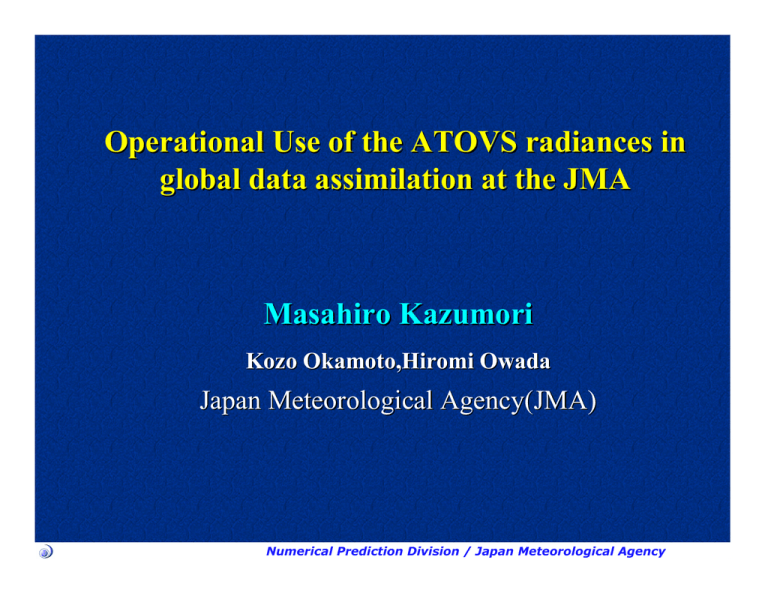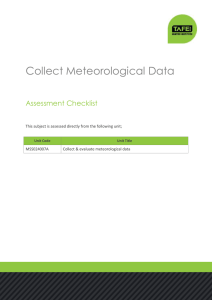Operational Use of the ATOVS radiances in Masahiro Kazumori
advertisement

Operational Use of the ATOVS radiances in global data assimilation at the JMA Masahiro Kazumori Kozo Okamoto,Hiromi Owada Japan Meteorological Agency(JMA) Numerical Prediction Division / Japan Meteorological Agency Recent Progress of Satellite Data Assimilation in JMA Global data assimilation l l l Sep 25 2001 implementation of 3D-Var global data assimilation May 6 2003 use of QuikScat sea surface wind data May 6 2003 use of Meteosat high-density atmospheric motion Wind data l May 28 2003 start of operational direct assimilation of NOAA15&16 ATOVS radiance + new cumulus parameterization scheme Previous Status Retrievals use NESDIS retrieved thickness GMS-5 moisture data ls a v ie r t re l a ov m Re Current Status Radiances use NESDIS Level 1D TBB (HIRS/3, AMSU-A) NESDIS Level 1C TBB (AMSU-B) Less Conversion Error Numerical Prediction Division / Japan Meteorological Agency Processing of ATOVS radiances NESDIS LevelLevel-1D HIRS/3,AMSUA Thinned levellevel-1C AMSUAMSU-B GTS&Internet JMA 1D-Var as Pre-processor · · · · · Thinning Quality Check Bias Correction Channel Selection Obs Error Assignment levellevel-1B AMSUAMSU-A,AMSUA,AMSU-B Not in use J= (x(x-xb) (x-xb)TB-1(x+ (y(y-H(x)) (y-H(x))TR-1(y• • • Global Analysis with 3D-Var X:analysis variables – T & lnQ at 41 levels of GSM and Tskin Y : observation – HIRS/AMSUA/AMSUB TBB from NESDIS BUFR – AMSUA is mapped to HIRS H : observation operator – RTTOVRTTOV-6 (Saunders et al.,2000) · RTTOV-6 · Incremental 3D-Var(Inner T106L40) · Model Top 0.4hPa Global Spectral Model(T213L40) Numerical Prediction Division / Japan Meteorological Agency Change of distribution of available data Thinning • Constant distance – – • Temperature(thickness) retrieved by NESDIS 250km(HIRS/AMSA) 180km(AMSUB) Priority is given to – – clear radiances satellite closer to analysis time Use of data on Land in the upper air. Numerical Prediction Division / Japan Meteorological Agency JMA TBB Bias Correction scheme BIASj (n) = a j 0 + ∑i =1 a ji (n) X ji (n) 5 BIAS=<TBobs- TBcal> global mean and 1-Year averaged dataset TBobs: Observed TBB(Collocated with RAOB within 2degree & 90min) TBcal: Calculated from profiles of RAOB RAOB are used due to the presence of a model bias Guess is used to complement the lack of the upper stratosphere temp. temp. & moist. Predictors X AMSU-A Ch5 Calculated TBB AMSU-A Ch7 Calculated TBB AMSU-A Ch10 Calculated TBB TPW(Total Precipitable Water from first guess) Surface Temperature(JMA SST Analysis) The coefficients was defined every scan position. (There are 56scan position due to level 1D data mapped to HIRS Spot) Not bias-correct AMSU-A12-14, AMSU-B, HIRS11-12 due to large model bias Numerical Prediction Division / Japan Meteorological Agency Complicated Scan Bias of Level 1D data With BIAS Correction W/O BIAS Correction Effect of Mapping to HIRS Spot AMSU-A Ch4 AMSU-A Ch5 AMSU-A Ch6 AMSU-A Ch7 AMSU-A Ch8 AMSU-A Ch9 AMSU-A Ch10 AMSU-A Ch11 From:2003/06/27 To:2003/06/30 AMSU-A Ch12 AMSU-A Ch13 AMSU-A Ch14 Numerical Prediction Division / Japan Meteorological Agency Cycle Experiments Period 2001 December 2002 July Model JMA Global Spectrum Model : T213L40 Assimilation system : 3D-Var with RTTOV-6 Setting CNTL ATOVS Retrievals assimilation TEST ATOVS radiance assimilation NOAA15,NOAA16, HIRS/3,AMSU-A,AMSU-B Numerical Prediction Division / Japan Meteorological Agency Change of Analysis Increment Temperature (Zonal mean) CNTL TEST d !! a e lly r Sp ica t r ve Moisture 850hPa (Specific Humidity) CNTL TEST !! y ll a b o Gl Numerical Prediction Division / Japan Meteorological Agency Analysis Impact for Temperature Zonal Averaged Monthly Mean July 2002 CNTL Verification against RAOB Temperature BIAS Error 20S-20N TEST CNTL TEST Smooth!! Decrease of Bias!! Numerical Prediction Division / Japan Meteorological Agency Analysis Impact for Humidity Effect of ATOVS moisture channels (HIRS/3:ch10,ch11,ch12 & AMSU-B:ch3,ch4,ch5) Validation against Large impact on Total precipitable water in tropics was found. SSM/I TPW Difference(CNTL-SSM/I) N.H. Red:TEST - SSM/I Blue:CNTL - SSM/I Trop S.H. Difference(TEST-SSM/I) (2002/07/15 12UTC) Humidity field is close to SSM/I observation and became realistic!! Numerical Prediction Division / Japan Meteorological Agency Forecast Impact 500hPa Geopotential Height Verification against RAOB CNTL Jul2002 Jul2002 RMSE BIAS RMSE BIAS TEST Dec2001 Dec2001 RMSE BIAS RMSE BIAS N.H. Positive Tropics Impact!! S.H. Numerical Prediction Division / Japan Meteorological Agency RMSE of 500hPa geopotential height improved especially in former part of Forecast time. RMSE Difference(TEST-CNTL) 24hour Forecast(30days ave.) Dec2001 Dec2001 TEST CNTL TEST CNTL RMSE(m) l a ob l G Jul2002 Jul2002 RMSE(m) Forecast Score Z500 (against Initial) l a ob l G TEST CNTL TEST CNTL Impact is remarkable on Southern Hemisphere in 24hour forecast!! Numerical Prediction Division / Japan Meteorological Agency Case Study: Typhoon Track Prediction 500hPa geopotential height Analysis 27 May 2003 12UTC INIT Forecast(TEST) Difference Forecast(CNTL) Difference Analysis TEST CNTL Tip of arrow means 36hour forecast Forecast of strength of subtropic high pressure affects forecast of typhoon track prediction. Numerical Prediction Division / Japan Meteorological Agency Comparison with Other NWP Center JMA: Direct assimilation ATOVS radiances JMA: Retrievals assimilation ECMWF UKMO NCEP CANADA Improvement of 24hour forecast is remarkable!! RMSE of Global 500hPa Height Dec 2001 Jul 2002 FT=120 FT=72 FT=24 Numerical Prediction Division / Japan Meteorological Agency Summary and Ongoing Work • Since 28 May 2003, JMA has started direct assimilation of ATOVS radiances in global 3d-Var operationally. • In the experiments, analyzed temperature and humidity field were verified and became realistic. • For forecast skills, very positive impact was found, especially, in tropics and southern hemisphere at short term forecast. But, the improvement in northern hemisphere was not large. Moreover, to improve forecast skills, • we have some plans and are going to. – Use level 1B data, – Revise TBB bias correction scheme, – Use NOAA 17 (HIRS,AMSU-A,AMSU-B) – Upgrade radiative tranfer model (RTTOV-6 ---> RTTOV-7) – Use other new satellite data SSM/I,TRMM,AMSE,AIRS etc. Numerical Prediction Division / Japan Meteorological Agency




